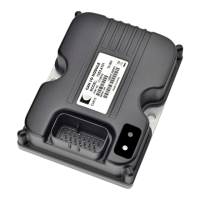5 — SDO COMMUNICATIONS
Curtis 1353 CANopen Expansion Module Manual – June 2017 Return to TOC
pg. 24
SDO 1353 Response (SDO-MISO)
An SDO request is always acknowledged with a response message from the 1353. e 1353 can issue
two kinds of response messages: a normal response or, in case of an error in the request SDO, an
Abort SDO Transfer message.
SDO-MOSI (sent by the 1353 in response to the system master)
Byte 1 Byte 2 Byte 3 Byte 4 Byte 5 Byte 6 Byte 7 Byte 8
Control CAN Object
Index
Sub-index Data: either the requested Read values,
or the actual Write values, or an error code
e rst data byte of the response contains an acknowledge code, which depends on the type of
transfer that was initially requested.
Action Byte 1 Value
Read Response 0x42
Write Acknowledge 0x60
Abort SDO 0x80
Data bytes 2, 3, and 4 hold the CAN Object index and sub-index of the request SDO.
If the SDO was a read command (a request for data from the 1353), data bytes 5 through 8 will be
lled with the requested values, with the LSB in data byte 5 and the next least signicant in byte 6
and so forth. All unused bytes are set to 0.
If the SDO was a write command, data bytes 5 through 8 will return the actual value written in bytes
5 – 8. In this way, if the 1353 needs to limit or round-down the SDO write request, the master will
know—because the return value will be dierent than the sent value.
If the SDO-MOSI did not properly read or tried to access a parameter improperly, an Abort SDO
Transfer will be sent. Data bytes 5 through 8 will be lled with a 32-bit error code.
0x06020000 = Object does not exist
0x06010002 = Attempt to write to a read only object.
TYPES OF SDO OBJECTS
ree types of SDO objects are described in the following pages: Communications Prole Objects
(address range 0x1000), Device Parameter Objects (address range 0x3000), and Device Monitor Objects
(address range 0x3100).

